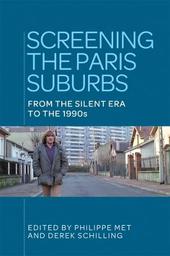
|
Screening the Paris Suburbs: From the Silent Era to the 1990s
Hardback
Main Details
| Title |
Screening the Paris Suburbs: From the Silent Era to the 1990s
|
| Authors and Contributors |
Edited by Philippe Met
|
|
Edited by Derek Schilling
|
| Physical Properties |
| Format:Hardback | | Pages:248 | | Dimensions(mm): Height 234,Width 156 |
|
| Category/Genre | Film theory and criticism |
|---|
| ISBN/Barcode |
9781526106858
|
| Classifications | Dewey:791.430944361 |
|---|
| Audience | | Tertiary Education (US: College) | | Professional & Vocational | |
|---|
| Illustrations |
36 black & white illustrations
|
|
Publishing Details |
| Publisher |
Manchester University Press
|
| Imprint |
Manchester University Press
|
| Publication Date |
5 February 2018 |
| Publication Country |
United Kingdom
|
Description
Decades before the emergence of a French self-styled 'hood' film around 1995, French filmmakers looked beyond the gates of the capital for inspiration and content. In the Paris suburbs they found an inexhaustible reservoir of forms, landscapes and social types in which to anchor their fictions, from bourgeois villas and bucolic riverside cafes to post-war housing estates and postmodern new towns. For the first time in English, contributors to this volume address key aspects of this long film history, marked by such towering figures as Jean Renoir, Jacques Tati and Jean-Luc Godard. Idyllic or menacing, expansive or claustrophobic, the suburb served divergent aesthetic and ideological programmes across the better part of a century. Themes central to French cultural modernity - class conflict, leisure, boredom and anti-authoritarianism - cut across the fifteen chapters. -- .
Author Biography
Philippe Met is Professor of French and Cinema Studies at the University of Pennsylvania Derek Schilling is Professor of French at Johns Hopkins University -- .
Reviews'This edited volume is an important contribution to conceptions of geography and French cinema. The fifteen contributions address the banlieue in film as geographic suburb and mise-en-scene that is both incidental landscape and elemental context for cinematic storytelling. Overall, the volume demonstrates how notions of banlieue cinema allow us to reconsider well-known French interwar and postwar films with an awareness of the postcolonial and hip-hop discourses that have over-coded an underlying historical context. The richness of this approach lies in how it foregrounds spatial dynamics within the Hexagon, or metropolitan France, as supplemented by longstanding histories of migration and regional idioms [...] A wide range of perspectives thus describe and reconsider the "space of periphery" in French cinema.' Peter J. Bloom, University of California, H-France Review, Vol. 19 (2019) -- .
|